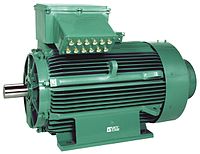
Photo from wikipedia
In this article, in order to improve the muzzle velocity and energy conversion efficiency of the synchronous induction coil launcher (SICL), the polarity reversal problem is studied. The circuit model… Click to show full abstract
In this article, in order to improve the muzzle velocity and energy conversion efficiency of the synchronous induction coil launcher (SICL), the polarity reversal problem is studied. The circuit model of a six-stage SICL is built for low-speed launching, a 40-stage SICL is built for medium- and high-speed launching, and the validity of the circuit model is verified by the transient field coupled model based on finite element software. For the six-stage launcher, if the trigger timing is unchanged and the polarity of the last three stages is just reversed, the armature will bear greater braking force and the armature temperature rises sharply, eventually leading to a significant decrease in muzzle velocity. By analyzing the variation of the driving currents and the induced eddy currents in the armature, the reason for the significant braking force is discussed. Based on this, we propose a method to significantly improve the launch performance by delaying the coils with reversed polarity. For the 40-stage launcher, maintain the polarity of the first 20 stages unchanged and reverse the polarity of the latter 20 stages. In addition, since the number of turns and the trigger time are calculated by the adaptive method, the braking effect is slowed down by increasing the coil pitch of the 20th and 21st stages. The simulation results show that the polarity reversal can also lift the downward acceleration, thus improving the energy conversion efficiency.
Journal Title: IEEE Transactions on Plasma Science
Year Published: 2020
Link to full text (if available)
Share on Social Media: Sign Up to like & get
recommendations!